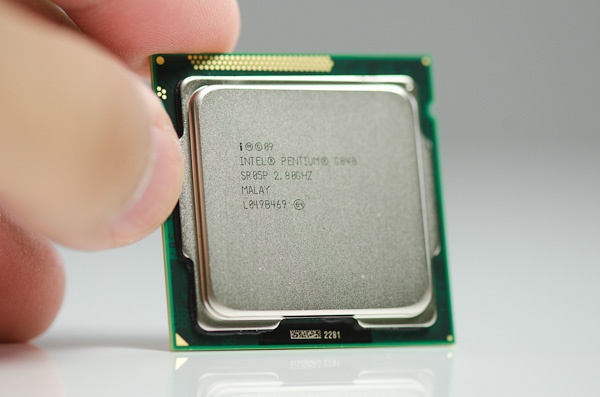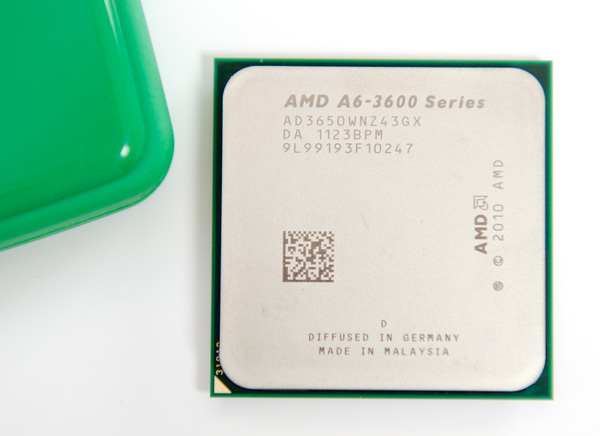The Sandy Bridge Pentium Review: G850, G840, G620 & G620T Tested
by Anand Lal Shimpi on August 23, 2011 12:11 AM ESTFinal Words
Despite boasting Intel's latest Sandy Bridge microarchitecture, the conclusions here are pretty much unchanged from the past. Intel maintains an advantage when it goes up against an AMD chip with the same number of cores, almost regardless of clock speed. In the case of the Pentium G620, even an Athlon II X2 265 with a 27% clock speed advantage can't outperform the Sandy Bridge based CPU. If you're choosing between chips with the same number of cores at the same price, Intel wins.
The decision tilts in AMD's favor if you start comparing to the Athlon II X3. In heavily threaded workloads, the Athlon II X3's third core helps put it ahead of the entire SNB Pentium lineup. If you're building a machine to do offline 3D rendering, multithreaded compiling or video transcoding then AMD continues to deliver the best performance per dollar. It's in the lighter, less threaded workloads that the Pentium pulls ahead. If you're building more of a general use system (email, web browsing, typical office applications and even discrete GPU gaming), the Pentium will likely deliver better performance thanks to its ILP advantages. What AMD has offered these past couple of years is an affordable way to get great multithreaded performance for those applications that need it.
Unfortunately the entire Sandy Bridge Pentium lineup is clock locked. Without turbo modes there's no support for overclocking at all. While these new Pentiums would have normally been great for enthusiasts looking to overclock, Intel has ensured that anyone looking to get more performance for free at the low end will have to shop AMD. Unfortunately Intel's advantage in single/lightly threaded performance is big enough that a clock speed advantage alone is generally not enough to make up for it (see G620 vs. Athlon II X2 265 comparison). It's sad that it has come to this. I was hoping we'd see more K-series SKUs at the low end but it seems like those will only be for the enthusiasts at the high end.
The Pentium's on-die GPU isn't particularly impressive. It's the HD Graphics 2000 from the rest of the Sandy Bridge lineup without Quick Sync or any of the extra video features. I am particularly sad that Quick Sync is missing as it would've made these Pentiums extremely attractive for users that do a lot of video transcoding. Thankfully video decode acceleration and HD audio bitstreaming support remain, so if you're looking to build a cheap Sandy Bridge based HTPC and don't care about the frills these chips will work just fine.
However, if you're building a system to do any sort of 3D gaming you're much better off either springing for a cheap discrete card or looking at AMD's A6-3650 if you want to stay integrated. Although you can play older titles at low resolution on the Pentium's on-board GPU, you'll have a much better experience with a discrete GPU or with the A6.
It all boils down to this. If you want a good, cheap, general purpose PC then the Pentium G620 seems competent and cheap. You can consider the G840 if you want a bit more performance. If you do a lot of threaded work (e.g. offline 3D rendering) the next step up is the Athlon II X3 455. If you do any amount of consumer level video transcoding using apps that are Quick Sync enabled, opt for the Core i3 2100 instead. If gaming is important to you then either buy a discrete GPU or look to AMD's Llano.
As far as AMD's A6 vs. A8 goes, the A8-3850 only commands a $20 price premium over the A6-3650. That $20 gives you another 8 - 10% on the CPU side and around 20% on the GPU. In my opinion, if you're considering a Llano system - spring for the A8.












110 Comments
View All Comments
Taft12 - Tuesday, August 23, 2011 - link
People who visit AT are the last holdouts of the desktop PC generation.philosofool - Wednesday, August 24, 2011 - link
Businesses and schools. Or, about half the market for computers.alent1234 - Tuesday, August 23, 2011 - link
last year i bought a $299 laptop as a gift for someone. it's more than enough for that person.i actually wanted to buy them an ipad but my wife said laptop
Yowen - Monday, August 29, 2011 - link
Yeah, for personal use that's fine, but I'd love to run it for the hours that I run my desktop at work and see how long it lasts. So there is still a very sizable market for desktops.averik - Tuesday, August 23, 2011 - link
I don't think so. We recently bought 24 G620 Pentiums to replace socket 478 Pentium 4s in 2 highschools.The CPU market for doing "basic staff" is quite large, and its impressive that G620 is almost as powerful as the Core 2 E8500 which had a release price of $266.
philosofool - Wednesday, August 24, 2011 - link
Exactly.This review is naturally targeted at the single user building his own system.
If you're a public library or a high school or a medium sized office looking to upgrade 20 computers that are running 9am to 9pm daily, a 35W pentium destroys the competition. A 100W anything is a waste of money because the extra 1300W power consumption bites would cost you quite a lot of money in electricity. The power company charges a lot more when you're consuming a lot of power (like a business) than when you're consuming a little (like a home.)
yankeeDDL - Thursday, August 25, 2011 - link
Guys, please, let't be serious.You cannot possibly do considerations on power consumption by looking at a chart showing the power under load, do you?
If you do, then you should have bought Atoms: at 9W they're for sure much better than any Athlon and G*.
So why didn't you buy an Atom instead? Exactly, because it's slow.
What good does it make to use less power, if it takes you longer to do the same thing?
The G620, under load, consumes about 55% of the Athlon X3, but the Athlon takes 60% of the time that the G620 takes to do the same task (I'm looking at the x264 charts). So the difference between these two, under load, is anecdotal, at best.
So, I'm sorry for your highschools, but you did not save them much money in electricity. Infact, considering how more expensive the MoBos for SB are, you probably ended up making them pay more.
averik - Monday, August 29, 2011 - link
Cost of Athlon X3 + cheap Asus mboard = Cost of G620 + cheap Asus H61 mboard (about 125 Euros).Athlon X3 is a great CPU and in fact I use one at work. But most of the time CPUs are idle. We dont do any x264 work. In fact, i believe the typical hardest daily job of a CPU is to startup windows, antivirus etc.
In the low badget market you cannot go awfully wrong, so even Athlon X2 is a good choice, but AMDs line is aged. Pentium G*s on the other hand offer comperable performance at same price on a newer platform.
yankeeDDL - Friday, September 2, 2011 - link
Averik,respectfully, I disagree.
From Newegg: Biostar N68S = $40, Ath II X3 440 = $65
Biostar H61ML = $50 G620 = $75
Delta: $20 (out of $105, it's ~20%).
Note: the MoBos are the cheapest I found. The one for AMD also has onboard Video, saving you a few extra bucks if you don't do gaming.
If you are an extremely "light" user (email + web browsing), then neither the G620 or the Athlon X3 make much sense: Brazos (either the E-350 or the C-50) make a lot more sense, since their power consumption is abismal compared to the other two, and they pack plenty of speed for those tasks. Plus, the on-chip GPU accelerates web content nicely.
If you add to the mix some casual gaming, Brazos can even handle it, but it won't compare with either the Athlon of the G620. If you trust Tom's hardware, you can see that they recommend the X3 easily, because of the 3rd core, which helps in several scenario, despite the lower efficiency over the 2 cores of the G620.
I can imagine only some very, very specific scenarios (very limited budget, low PSU capacity, occasional gaming, lots of encryption) where the G620 has a slight edge over the X3, but that's far from average Joe budget PC.
You're totally right about not going "awfully" wrong with the G620, nevertheless, you do pay the "Intel" brand price over a slightly less performing CPU.
You're also right about AMD line being aged, but again, if you are looking at G620, you are looking into budget-oriented systems: not something you change every other day, so what is wrong wit being aged? In my view, you can find tons of good combo deals, and maybe even used parts, which could dramatically drop your costs.
Also, Intel isn't exactly famous for keeping things compatible: it wouldn't be the 1st time that the socket gets quickly outdated (was it really necessary to have a socket 1156 and an 1155?), while AMD's socket gets you covered up to the Phenom II X4, for a dirt-cheap bump in performance.
That's the way I see it at least. I would love to see the prices of the G620 going below $50: that would be a real deal (and I'm sure would push AMD's prices even lower). Till that happens, for budget, I buy AMD, which gives the best bangs for the bucks.
averik - Sunday, September 4, 2011 - link
yankeeDDL, I agree with many of your points (especially changing sockets). Please note however that best prices or used items are not an option for some buyers.The scenario is extremely light use (email, web browsing, ms office, thin-client intranet applications, light educational applications), but the investment has to last for 5-10 years (we are replacing P4s - I know its a shame). I am not sure how heavily threaded the environment will be in then. If it is, then yes, Athlon X3 will perform a bit better. If not, then G620 having better single-thread performance will be better. Both will be old though.
I also found the case of E350 very interesting - to replace bulkier equipment with ITX motherboards and small cases - so I built one for home and use it daily. My conclusion is something like Brazos will be a good mid-term investment for basic office use if (1) they get 50% better CPU power (graphics are ok) and (2) availability of PSUs for ITX cases gets better - I mean it should be as trivial to find a replacement as a regular PSU is. But sure, thats the way of things to come.
As for G620 going below $50, I dont have high hopes. Maybe the cheapest Bulldozers (when they appear) will force Intel to do that - but why go for G620 then?
I really liked reading your comments.